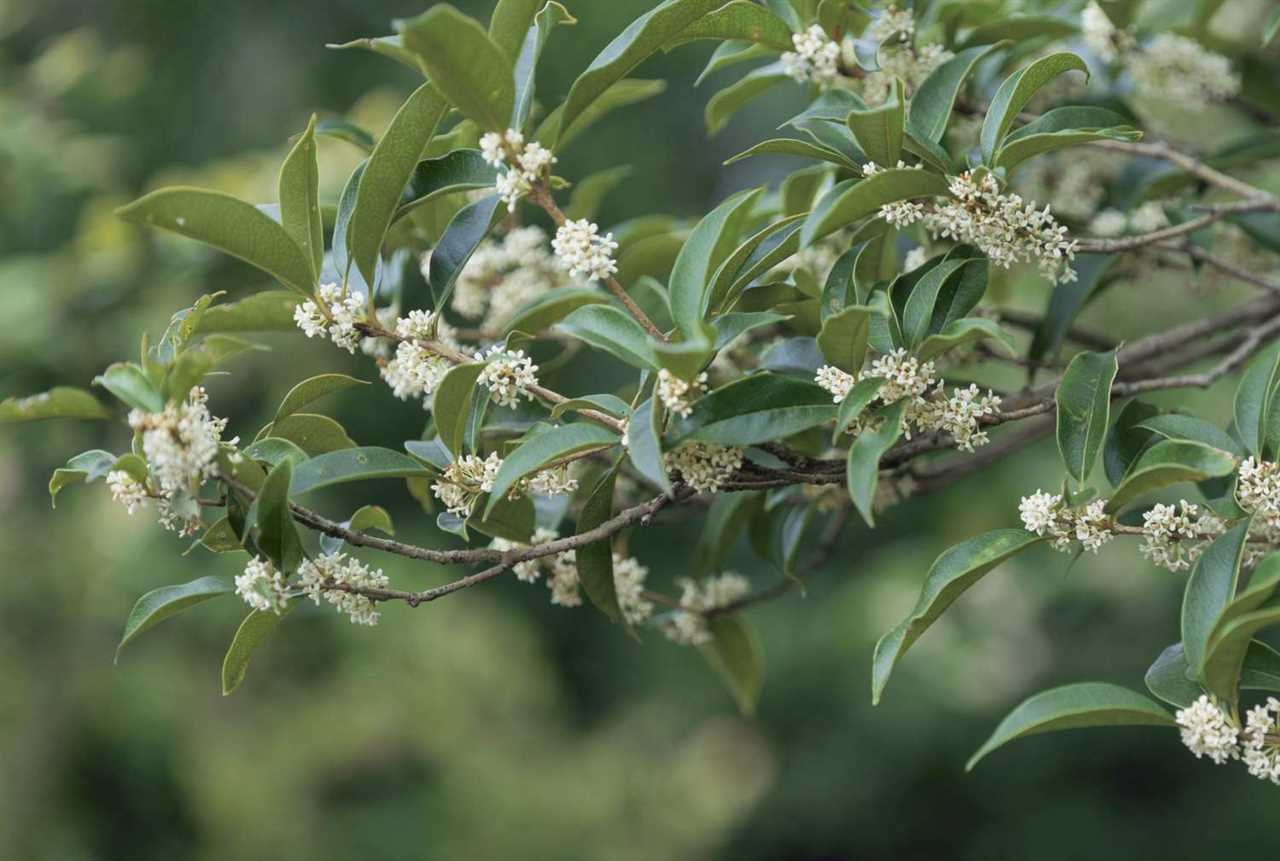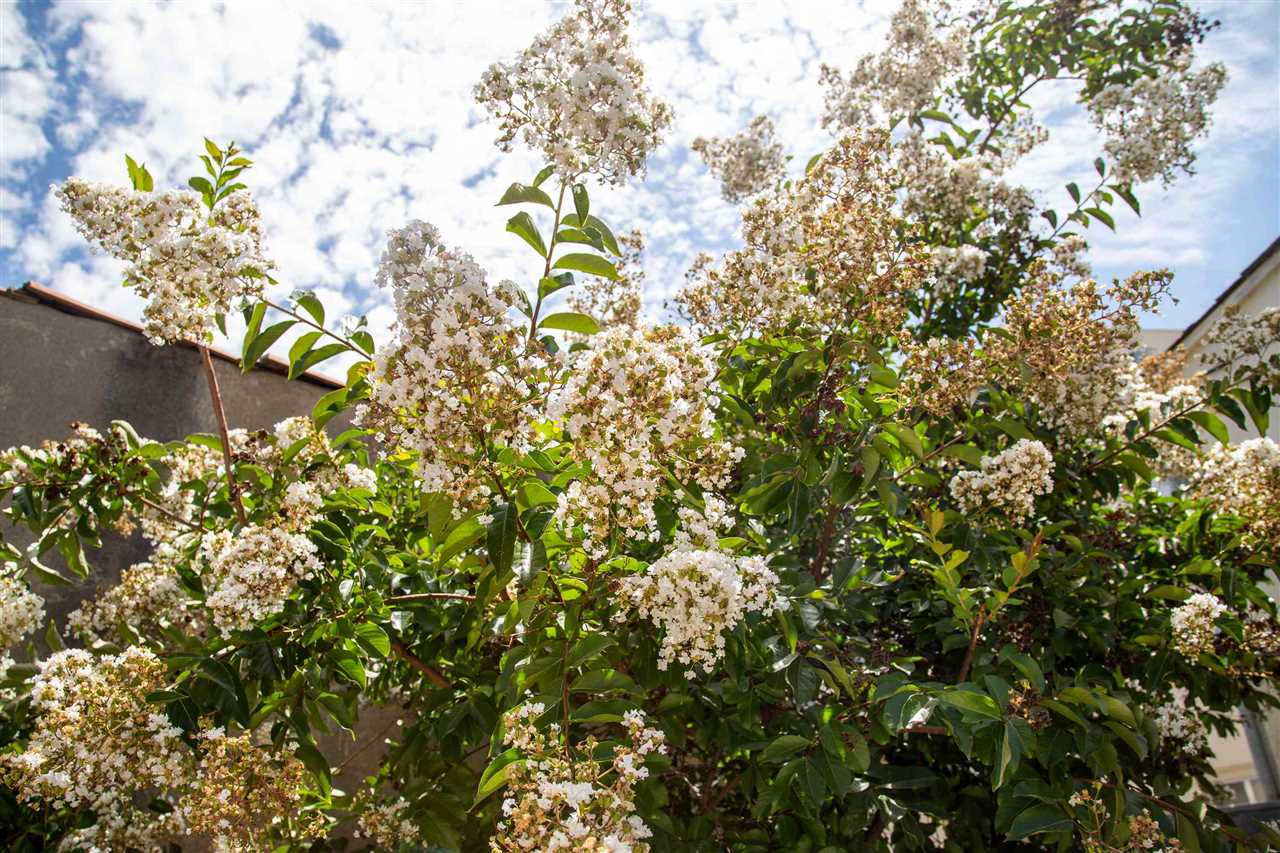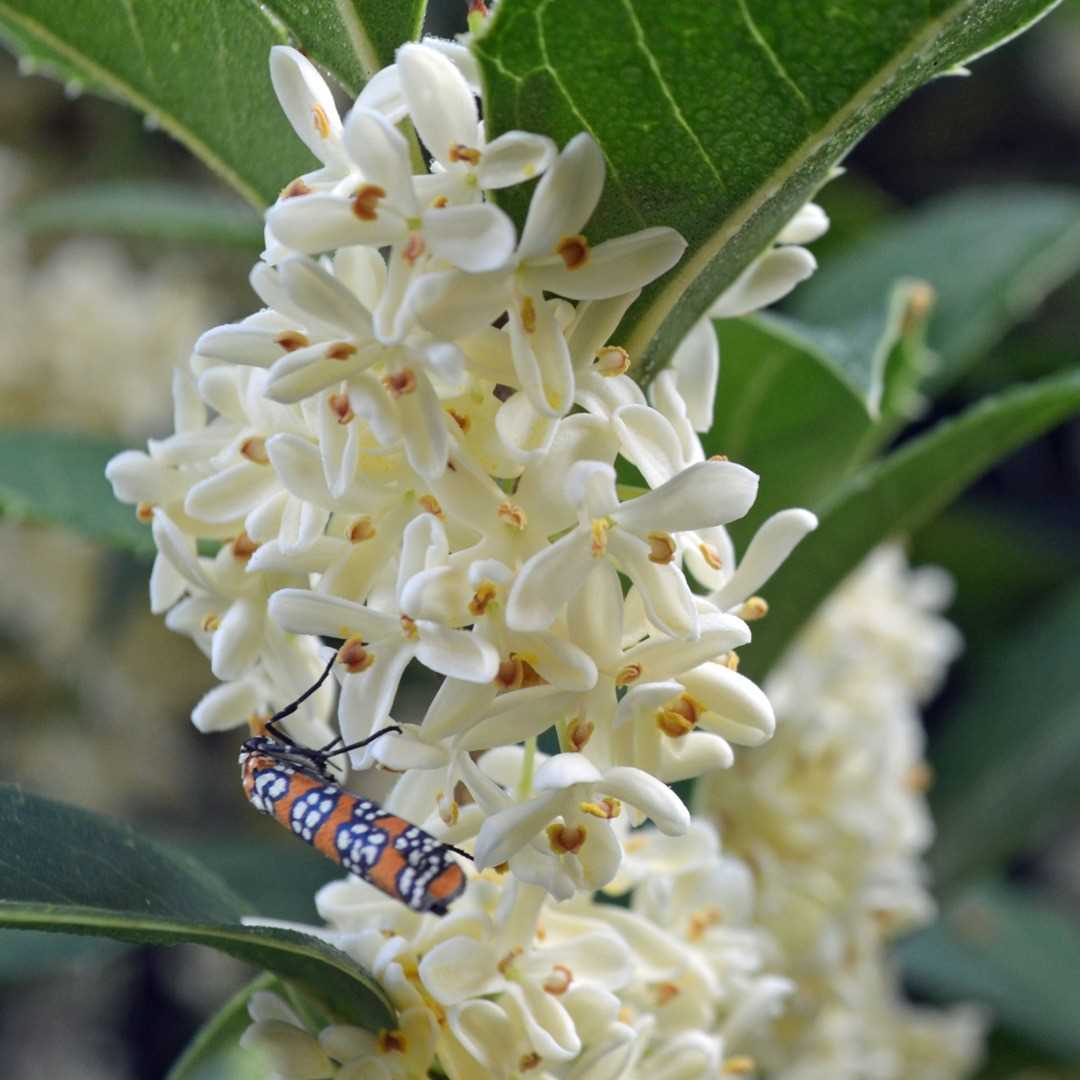Contents
- 1 Osmanthus Fragrans A Guide to Growing and Caring for Fragrant Osmanthus
Osmanthus Fragrans A Guide to Growing and Caring for Fragrant Osmanthus

Discover the sweet and delicate beauty of the Osmanthus fragrans, a flower renowned for its intoxicating scent. With its scented blooms and rich history in China, the Osmanthus fragrans is a true treasure for any garden.
What is Osmanthus fragrans?
The Osmanthus fragrans, also known as the sweet osmanthus or tea olive, is a flowering plant native to China. It is prized for its small, white or yellow flowers that release a strong and delightful aroma. In fact, the name “fragrans” comes from the Latin word for “fragrant,” a testament to the captivating scent of this flower.
How to grow and care for Osmanthus fragrans
To grow Osmanthus fragrans, you will need a sunny spot in your garden with well-draining soil. This versatile plant can tolerate a range of soil types, but it thrives in slightly acidic soil. Plant your Osmanthus fragrans in the spring or fall, and make sure to water it regularly, especially during dry spells.
Pro tip: Add organic matter, such as compost or well-rotted manure, to the soil before planting to improve its fertility and drainage.
Once established, your Osmanthus fragrans will reward you with its beautiful and scented flowers. These flowers are not only a delight for the senses but also attract pollinators like bees and butterflies to your garden.
“The aroma of Osmanthus fragrans is often compared to that of ripe peaches or apricots, with hints of jasmine and vanilla.”
Aside from its ornamental value, the Osmanthus fragrans has a long history of use in traditional Chinese medicine and tea-making. The flowers can be used to make a fragrant and soothing tea that is said to have various health benefits.
So why not bring a touch of China’s rich history and heavenly aroma to your garden? Plant an Osmanthus fragrans and enjoy the sweet scent and beauty it brings.
What is Osmanthus Fragrans?

Osmanthus Fragrans, also known as the Fragrant Osmanthus, is a species of flowering plant native to China. It is highly valued for its beautiful and fragrant flowers, which are used to produce perfume, tea, and scented oils.
The flowers of Osmanthus Fragrans are small and white or yellow in color. They have a sweet aroma that is often compared to the scent of apricots or peaches. The fragrance of the flowers is so strong that it can fill an entire room.
Osmanthus Fragrans is often used in traditional Chinese medicine for its medicinal properties. The flowers are believed to have a calming effect on the mind and body, and they are often used to treat anxiety and insomnia.
In addition to its medicinal uses, Osmanthus Fragrans is also used in culinary applications. The flowers can be used to flavor teas, desserts, and alcoholic beverages. They are also used to make jams, jellies, and syrups.
If you are looking for a beautiful and fragrant flower to add to your garden, Osmanthus Fragrans is a great choice. Its sweet aroma and delicate flowers will add a touch of elegance to any landscape.
Why Grow Osmanthus Fragrans?

The scented flower of Osmanthus Fragrans, also known as Sweet Osmanthus or Tea Olive, is native to China and is highly prized for its sweet perfume-like aroma. Here are a few reasons why you should consider growing this fragrant plant:
- Beautiful and Fragrant: The flowers of Osmanthus Fragrans are not only visually stunning, but they also emit a delightful fragrance that fills the air.
- Tea Production: In China, the flowers of Osmanthus Fragrans are often used to flavor tea. Adding a few dried flowers to your tea can enhance its flavor and aroma.
- Attracts Pollinators: The sweet fragrance of Osmanthus Fragrans flowers attracts bees, butterflies, and other pollinators to your garden, helping to promote biodiversity.
- Easy to Grow: Osmanthus Fragrans is a hardy plant that can tolerate a wide range of growing conditions. It is relatively low-maintenance and can thrive in both sunny and partially shaded areas.
- Ornamental Value: In addition to its fragrance, Osmanthus Fragrans also has ornamental value. Its glossy evergreen leaves provide year-round interest and its dense growth habit makes it a great choice for hedges or privacy screens.
Whether you are a tea lover, a garden enthusiast, or simply someone who appreciates the beauty and aroma of flowers, growing Osmanthus Fragrans is a wonderful addition to any garden.
Where to Grow Osmanthus Fragrans?

The Osmanthus Fragrans, also known as sweet tea or fragrans, is a flowering plant native to China. It is renowned for its delicate aroma, which resembles the scent of ripe peaches or apricots. The perfume-like fragrance of the osmanthus flowers makes it a popular choice for perfumes and scented products.
If you are considering growing osmanthus fragrans, here are some important factors to consider:
- Climate: Osmanthus fragrans thrives in temperate climates with mild winters and warm summers. It can tolerate a range of temperatures, but it prefers a climate with a minimum temperature of 10°C (50°F) and a maximum temperature of 30°C (86°F).
- Sunlight: Osmanthus fragrans prefers full sun to partial shade. It needs at least 4-6 hours of direct sunlight per day to bloom and grow properly.
- Soil: Osmanthus fragrans prefers well-draining soil that is rich in organic matter. It can tolerate a wide range of soil types, including sandy, loamy, and clay soils.
- Water: Osmanthus fragrans has moderate water needs. It prefers evenly moist soil but can tolerate short periods of drought once established. Avoid overwatering, as it can lead to root rot.
- Location: Choose a location in your garden that provides good air circulation and protection from strong winds. Osmanthus fragrans can be grown in containers or as a hedge, making it a versatile plant for various garden designs.
By providing the right growing conditions, you can enjoy the beautiful flowers and intoxicating fragrance of osmanthus fragrans in your garden. Whether you want to create a scented garden or add a touch of elegance to your landscape, osmanthus fragrans is a wonderful choice.
Growing Osmanthus Fragrans

Osmanthus Fragrans, also known as sweet osmanthus or fragrant osmanthus, is a flowering plant native to China. It is well-loved for its delightful aroma, which is often described as a mix of apricot, peach, and floral notes. The flowers of Osmanthus Fragrans are often used to make tea and perfume due to their sweet fragrance.
If you are interested in growing Osmanthus Fragrans, here are some tips to help you get started:
- Location: Osmanthus Fragrans thrives in sunny or partially shaded areas. It is best to plant it in well-draining soil.
- Watering: This plant prefers regular watering, especially during dry periods. However, it is important not to overwater, as this can lead to root rot.
- Pruning: Pruning Osmanthus Fragrans is not necessary, but it can help maintain its shape and promote better flowering.
- Fertilizing: You can fertilize Osmanthus Fragrans once a year in the spring using a slow-release fertilizer.
- Propagation: You can propagate Osmanthus Fragrans through seeds or cuttings. Seeds should be soaked in water for 24 hours before planting, while cuttings should be taken in the summer.
Overall, growing Osmanthus Fragrans can be a rewarding experience. Its beautiful flowers and sweet aroma will surely add a touch of elegance and fragrance to your garden.
Choosing the Right Location

When it comes to growing Osmanthus Fragrans, choosing the right location is crucial for the success of your plant. This flower, also known as the tea olive or sweet olive, is native to China and is famous for its delightful aroma.
The Osmanthus Fragrans plant thrives in a sunny location with well-draining soil. It can tolerate some shade, but it will produce more flowers and have a stronger fragrance when grown in full sun.
It is important to select a location that is protected from strong winds, as the delicate flowers and leaves can be easily damaged. A sheltered spot against a wall or fence would be ideal.
When choosing the right location for your Osmanthus Fragrans plant, consider the proximity to other plants. This flower releases a strong perfume that can overpower other scents in the garden. Therefore, it is best to plant it away from other strongly scented flowers or perfumed plants.
Additionally, the Osmanthus Fragrans plant is quite versatile and can be grown in a variety of soil types. However, it prefers a slightly acidic soil with good drainage. If your soil is heavy or clay-like, you can improve it by adding organic matter, such as compost or well-rotted manure.
In summary, when choosing the right location for your Osmanthus Fragrans plant, keep in mind the following:
- Full sun or partial shade
- Protection from strong winds
- Away from other strongly scented flowers
- Slightly acidic soil with good drainage
By selecting the perfect location for your Osmanthus Fragrans plant, you can ensure that it thrives and fills your garden with its sweet and fragrant aroma.
Sunlight Requirements

Osmanthus fragrans, also known as the fragrant osmanthus, is a beautiful flower that is highly prized for its scented aroma. It is native to Asia and is commonly used in tea, perfumes, and other fragrant products.
When it comes to growing and caring for osmanthus, one of the most important factors to consider is sunlight requirements. This flower thrives in full sun to partial shade, so it is important to provide it with the right amount of sunlight to ensure healthy growth and abundant blooms.
Here are some key points to keep in mind when it comes to sunlight requirements for osmanthus:
- Full Sun: Osmanthus fragrans prefers full sun, which is defined as at least six hours of direct sunlight per day. When planted in an area that receives full sun, osmanthus will produce the most flowers and have the strongest aroma.
- Partial Shade: If you don’t have a spot in your garden that receives full sun, don’t worry! Osmanthus can also tolerate partial shade, which is defined as three to six hours of direct sunlight per day. While it may not produce as many flowers or as strong of an aroma as it would in full sun, it will still thrive and provide a sweet fragrance to your garden.
- Protection: If you live in an area with hot summers, it is important to protect your osmanthus from the intense afternoon sun. This can be done by planting it in a spot that receives morning sun and afternoon shade, or by providing some shade during the hottest part of the day.
By providing your osmanthus fragrans with the right amount of sunlight, you can ensure that it will thrive and provide you with its sweet perfume for years to come.
Soil Conditions

The Osmanthus fragrans, also known as the fragrant osmanthus or sweet osmanthus, is a flower native to China. It is highly valued for its scented flowers, which are often used to make tea and perfume.
In order to grow and care for fragrant osmanthus, it is important to provide the right soil conditions. The plant prefers well-drained soil that is rich in organic matter. The pH level of the soil should be slightly acidic to neutral, ideally between 6.0 and 7.0.
When planting fragrant osmanthus, it is recommended to prepare the soil by loosening it and removing any weeds or rocks. Adding compost or well-rotted manure to the soil will help improve its fertility and drainage.
It is important to ensure that the soil remains moist but not waterlogged. Overwatering can lead to root rot and other diseases, so it is important to monitor the moisture levels and adjust watering accordingly.
Additionally, providing a layer of mulch around the base of the plant can help retain moisture and suppress weed growth. This will also help to regulate soil temperature and protect the roots from extreme cold or heat.
Overall, by providing the right soil conditions, you can ensure that your fragrant osmanthus thrives and produces its beautiful scented flowers.
Climate Considerations

Growing fragrant Osmanthus (Osmanthus fragrans) requires the right climate conditions to ensure the sweet perfume of its flowers can be enjoyed to the fullest. Here are some important climate considerations to keep in mind when growing and caring for this scented flower:
- Temperature: Fragrant Osmanthus thrives in temperate climates with mild winters and warm summers. It is hardy in USDA zones 7 to 10, where temperatures typically range from 0°F (-18°C) to 100°F (38°C).
- Sunlight: These plants prefer full sun to partial shade. They need at least 6 hours of direct sunlight each day to ensure healthy growth and abundant flowering.
- Soil: Fragrant Osmanthus prefers well-draining soil that is rich in organic matter. A slightly acidic to neutral soil pH (around 6.0 to 7.0) is ideal for optimal growth.
- Water: While fragrant Osmanthus is drought-tolerant once established, regular watering is essential during the first year of growth. Water deeply and consistently, allowing the soil to dry out slightly between waterings.
- Frost Protection: In areas with occasional frost or freezing temperatures, provide frost protection by covering the plant with a breathable fabric or mulching around the base to protect the roots.
By considering these climate factors and providing the right conditions, you can enjoy the delightful fragrance and beauty of fragrant Osmanthus in your garden or landscape. Whether used for its aroma, as a scented tea, or simply for its captivating flowers, this plant is sure to bring joy and charm to any outdoor space.
Planting Osmanthus Fragrans

Osmanthus Fragrans, also known as Sweet Osmanthus or Fragrant Osmanthus, is a flowering plant native to China. It is highly valued for its sweet-scented flowers and aromatic perfume.
To successfully plant and care for Osmanthus Fragrans, follow these steps:
- Choose the right location: Osmanthus Fragrans thrives in well-drained soil and full sun to partial shade. It can tolerate a variety of soil types but prefers slightly acidic soil.
- Prepare the soil: Before planting, amend the soil with organic matter such as compost or peat moss to improve drainage and nutrient content.
- Dig the hole: Dig a hole that is slightly larger than the root ball of the plant. Make sure the hole is deep enough for the plant to sit at the same level as it was in the nursery pot.
- Plant the Osmanthus Fragrans: Gently remove the plant from its container and loosen the roots. Place the plant in the hole and backfill with soil, firming it gently around the roots.
- Water thoroughly: After planting, water the Osmanthus Fragrans thoroughly to settle the soil and remove any air pockets. Keep the soil moist but not waterlogged during the growing season.
- Mulch: Apply a layer of mulch around the base of the plant to help retain moisture and suppress weeds. Avoid piling the mulch against the trunk of the plant.
- Prune as needed: Osmanthus Fragrans generally requires minimal pruning. However, you can shape the plant or remove any dead or diseased branches as necessary.
- Fertilize: Feed the Osmanthus Fragrans with a balanced fertilizer in spring and summer to promote healthy growth and abundant flowering.
With proper care and maintenance, your Osmanthus Fragrans will reward you with its beautiful and fragrant flowers, filling your garden with a delightful aroma.
For more information on growing and caring for Osmanthus Fragrans, consult our expert gardening guides or visit our nursery for a wide selection of Osmanthus Fragrans plants.
Preparing the Soil

Proper soil preparation is essential for the successful cultivation of scented osmanthus flowers. Follow these steps to ensure your osmanthus plants thrive:
- Choose the right location: Osmanthus fragrans, also known as sweet osmanthus or tea olive, is native to China. It thrives in well-drained soil with a pH level between 6.5 and 7.5. Select a sunny or partially shaded spot in your garden to plant your osmanthus.
- Clear the area: Remove any weeds, rocks, or debris from the planting area. This will help prevent competition for nutrients and ensure your osmanthus has ample space to grow.
- Amend the soil: Osmanthus prefers loamy soil that is rich in organic matter. Add compost or well-rotted manure to improve soil fertility and drainage. Mix it thoroughly with the existing soil to create a nutrient-rich planting bed.
- Test the soil: It’s a good idea to test your soil before planting osmanthus. You can purchase a soil testing kit from a garden center or send a soil sample to a laboratory for analysis. This will help you determine if any additional amendments, such as limestone to raise pH or sulfur to lower pH, are needed.
- Water the soil: Before planting your osmanthus, water the soil thoroughly to ensure it is moist. This will help the roots establish more quickly and reduce transplant shock.
By following these soil preparation guidelines, you will create the perfect environment for your osmanthus fragrans to flourish and fill your garden with its sweet, fragrant perfume.
Video:Osmanthus Fragrans A Guide to Growing and Caring for Fragrant Osmanthus
HOW TO GROW AND ROOT A TEA OLIVE.
How to Propagate Hydrangeas |Simple Way to Get Cuttings to Root Faster|
Hello, I am Beverly J. Sanders, the voice behind the diverse articles you come across on styves.co.za. My passion lies in exploring the nuances of home improvement and sharing tips that can help you transform your living space into a haven of comfort and style. From the latest trends in home decor to practical cleaning advice, I cover a broad spectrum of topics to cater to a wide variety of interests.
In my recent works, I have delved into the advantages of incorporating a horizontal Murphy bed into your home to save space without compromising on design and functionality. I also explored the benefits of having a free-standing electric fireplace that not only adds warmth to your home but also brings a sleek and modern design to any living space. My articles are a rich resource, offering insights into different products and home improvement strategies that can enhance the quality of your life.
I believe in the power of details; a belief that reflects in my comprehensive guides where I discuss even the overlooked aspects of home decor, such as the impact of baseboard trim in enhancing the overall look and feel of your home. I am constantly on the lookout for innovative solutions and products that can add value to your home and life.
Join me in my exploration as I continue to bring you the latest trends, tips, and insights in the home improvement world. Let’s create a home that is not just a place to live, but a reflection of style and personality.